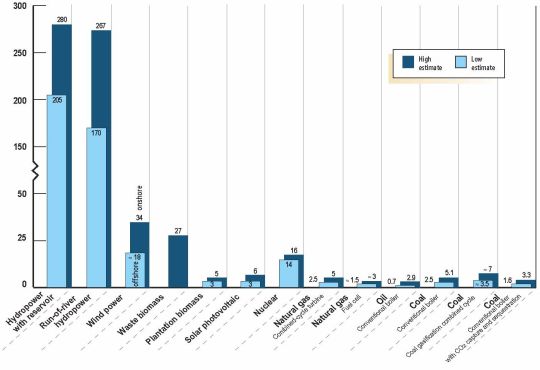The July/August 2007 issue of World Watch magazine (produced by the Worldwatch Institute) includes a concise demolition of carbon geosequestration in the form of a letter to the editor by one Luc Gagnon, “a senior advisor on climate change for Hydro-Quebec.”
I’d quote the letter but the Worldwatch site doesn’t have it online yet. So I went searching for more by Gagnon and found this short, powerful PDF making essentially the same point (in almost the same language). An interesting table indeed, of “energy payback ratio of electricity generation options based on life-cycle assessments”:

Short summary: No matter how much they dangle the subsidy-bait of carbon geosequestration back and forth like a gold watch in front of our eyes, trying to hypnotize us into the belief that the chimera called “clean coal” actually exists, there are a few key points to remember:
- coal is the enemy of the human race, and
- coal isn’t all that hot as an energy source to start with, once you factor in all the other energy costs.
Even if we were to stipulate that perfect geological storage of CO2 (from a leakage perspective) was attainable, the cost in energy makes it a killer for coal.
And the punch line is quoted below:
The future performance of fossil fuels
Fossil fuels already have low Energy Payback Ratios and these will probably be declining over the next decades. This is due to multiple factors:
- As the best oil and gas reserves are depleted, they tend to be replaced by wells that require a higher energy investment, as they are often located in far-away regions or under the sea. One obvious example is oil from tar sands. The process energy, mainly natural gas, required to extract oil from tar sands is five times greater than in the case of conventional oil. As a result, the Energy Payback Ratio of oil from tar sands drops from 2.9 to 0.7 if the oil is used in electricity generation. This means that directly burning the natural gas (used in the process) would generate more electricity. Therefore, the development of tar sands is only justified because oil is well suited as a fuel for the transportation sector.
- Various factors could also reduce the future performance of natural gas-fired generation. Longer delivery distances are probable. Moreover, a higher percentage of gas will be delivered by tanker ship, in the form of liquefied methane (at extremely cold temperatures). This type of delivery requires more energy than pipelines.
- Due to severe air quality problems in many countries, coal-fired plants will need to consume more energy to control emissions. There are two main methods of reducing SO2 emissions: using scrubbers (at the plant) to capture the SO2 or using low-sulfur coal. SO2 scrubbing can reduce the overall efficiency of coal-fired generation by 10 to 15%, and more energy is required to manage the sulfur wastes. In the U.S. in the last 20 years, most utilities decided not to install scrubbers and have achieved SO2 emission reductions by switching to low-sulfur coal from the Western states. Consequently, average transportation distance for coal has increased, with greater energy consumed in delivery. Thus, both approaches to controlling SO2 reduce the energy payback of coal-fired generation.
- If technologies for capturing and sequestering CO2 become commercially available, they will require huge amounts of energy. Capturing CO2 can reduce a plant’s efficiency by 25% and much energy will then be required to transport and sequester the waste stream. To appreciate the size of the challenge, it is relevant to compare it with SO2 scrubbing. Coal has a sulfur content of 1 or 2% and a carbon content of 70 to 80%. CO2 capture and sequestration is therefore 50 times more difficult. Since SO2 scrubbing has often been rejected, one may question the feasibility of large-scale CO2 capture …
Why is the Energy Payback Ratio a good environmental indicator?
When a system has a low Energy Payback Ratio, it means that it consumes large amounts of energy, with associated environmental impacts. For fossil fuels, it means significant impacts related to extraction, processing and transportation of the fuel, and also at the generation site. For renewable energy, environmental impacts can arise from the construction itself.


